World
Heritage Sites in
the United Kingdom
1.
England
•
City of Bath
•
Blenheim Palace
•
Canterbury Cathedral...
•
Derwent
Valley Mills
•
Dorset and
East
Devon
Coast
•
Hadrian's
Wall
•
Ironbridge Gorge
•
Maritime
Greenwich
•
Royal
Botanic Gardens,
Kew
•
Saltaire
•
Stonehenge, Avebury and
Associated Sites
•
Studley Royal Park including the Ruins of
Fountains Abbey
•
Tower of
London
•
Westminster
Palace,
Westminster Abbey and Saint Margaret's Church
2.
Northern Ireland
•
Giant's Causeway
3.
Scotland
•
Old and New Towns of
Edinburgh
•
New Lanark
•
The Heart of Neolithic Orkney
•
St. Kilda
4.
Wales
•
Blaenavon Industrial Landscape
•
Castles
and Town Walls of King Edward in Gwynedd
5.
Outside the
British
Isles
England
City of
Bath, England
(Inscribed:
1987)
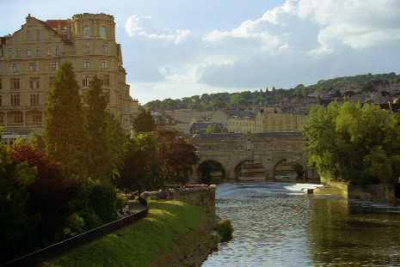 Founded by the Romans as a thermal
spa,
Bath
became an important centre of the wool industry in the Middle
Ages. In the 18th century, under George III, it developed into an elegant town
with neoclassical Palladian buildings, which blend harmoniously with the Roman
baths.
Founded by the Romans as a thermal
spa,
Bath
became an important centre of the wool industry in the Middle
Ages. In the 18th century, under George III, it developed into an elegant town
with neoclassical Palladian buildings, which blend harmoniously with the Roman
baths.
Blenheim
Palace,
England
(Inscribed:
1987)
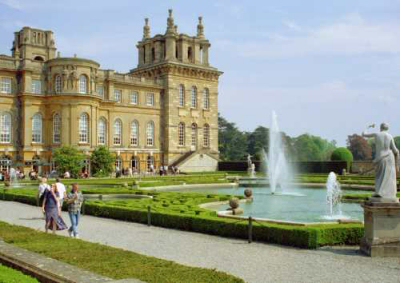 Blenheim
Palace, near
Oxford,
stands in a romantic park created by the famous landscape gardener 'Capability'
Brown. It was presented by the English nation to John Churchill, first Duke of
Marlborough, in recognition of his victory in 1704 over French and Bavarian
troops. Built between 1705 and 1722 and characterized by an eclectic style and
a return to national roots, it is a perfect example of an 18th-
century princely dwelling.
Blenheim
Palace, near
Oxford,
stands in a romantic park created by the famous landscape gardener 'Capability'
Brown. It was presented by the English nation to John Churchill, first Duke of
Marlborough, in recognition of his victory in 1704 over French and Bavarian
troops. Built between 1705 and 1722 and characterized by an eclectic style and
a return to national roots, it is a perfect example of an 18th-
century princely dwelling.
Canterbury Cathedral,
Saint Augustine's Abbey, and
Saint Martin's Church, England
(Inscribed:
1988)
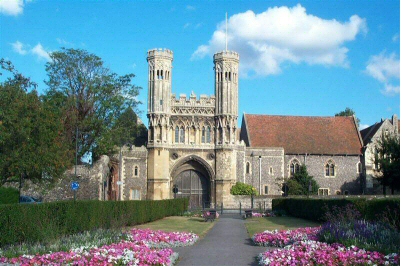 Canterbury, in
Kent, has
been the seat of the spiritual head of the Church of England for nearly five
centuries. Canterbury's other important monuments are the modest Church of St
Martin, the oldest church in England; the ruins of the Abbey of St Augustine (to
the left), a
reminder of the saint's evangelizing role in the Heptarchy
from 597; and Christ Church Cathedral, a breathtaking mixture of Romanesque and
Perpendicular Gothic, where Archbishop Thomas Becket was murdered in 1170.
Canterbury, in
Kent, has
been the seat of the spiritual head of the Church of England for nearly five
centuries. Canterbury's other important monuments are the modest Church of St
Martin, the oldest church in England; the ruins of the Abbey of St Augustine (to
the left), a
reminder of the saint's evangelizing role in the Heptarchy
from 597; and Christ Church Cathedral, a breathtaking mixture of Romanesque and
Perpendicular Gothic, where Archbishop Thomas Becket was murdered in 1170.
Derwent
Valley Mills, England
(Inscribed:
2001)
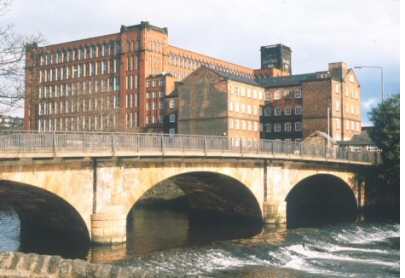 The
Derwent
Valley in central
England contains a series
of 18th and 19th-century cotton mills and an industrial landscape of high
historical and technological interest. The modern factory owes its origins to
the mills at Cromford, where Richard Arkwright's inventions were first put into industrial-scale
production. The workers' housing associated with this and the other mills
remains intact and illustrate the socio-economic
development of the area. The
Derwent
Valley saw the birth of
the factory system, when new types of building were erected to house the new
technology for spinning cotton developed by Richard Arkwright
in the early 19th c. In the
Derwent
Valley for the first
time there was large-scale industrial production in a rural landscape.
The need to provide housing and other facilities for workers and managers
resulted in the creation of the first modern industrial towns.
The
Derwent
Valley in central
England contains a series
of 18th and 19th-century cotton mills and an industrial landscape of high
historical and technological interest. The modern factory owes its origins to
the mills at Cromford, where Richard Arkwright's inventions were first put into industrial-scale
production. The workers' housing associated with this and the other mills
remains intact and illustrate the socio-economic
development of the area. The
Derwent
Valley saw the birth of
the factory system, when new types of building were erected to house the new
technology for spinning cotton developed by Richard Arkwright
in the early 19th c. In the
Derwent
Valley for the first
time there was large-scale industrial production in a rural landscape.
The need to provide housing and other facilities for workers and managers
resulted in the creation of the first modern industrial towns.
Dorset and
East
Devon
Coast,
England
(Inscribed:
2001)
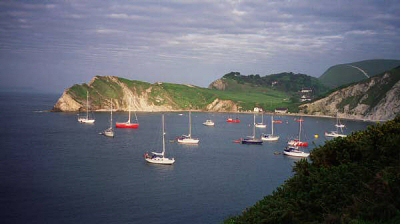 The cliff
exposures along the
Dorset and
East
Devon coast provide an almost continuous sequence of rock
formations spanning the Mesozoic Era, or some 185 million years of the earth's
history. The area's important fossil sites and classic coastal geomorphologic
features have contributed to the study of earth sciences for over 300 years.
The
Dorset and
East
Devon
Coast provides
an almost continuous sequence of Triassic, Jurassic and Cretaceous rock
formations spanning the Mesozoic Era, documenting approximately 185 million
years of Earth history. It also includes a range of internationally important
fossil localities – vertebrate and invertebrate, marine and terrestrial - which
have produced well-preserved and diverse evidence of life during Mesozoic
times.
The cliff
exposures along the
Dorset and
East
Devon coast provide an almost continuous sequence of rock
formations spanning the Mesozoic Era, or some 185 million years of the earth's
history. The area's important fossil sites and classic coastal geomorphologic
features have contributed to the study of earth sciences for over 300 years.
The
Dorset and
East
Devon
Coast provides
an almost continuous sequence of Triassic, Jurassic and Cretaceous rock
formations spanning the Mesozoic Era, documenting approximately 185 million
years of Earth history. It also includes a range of internationally important
fossil localities – vertebrate and invertebrate, marine and terrestrial - which
have produced well-preserved and diverse evidence of life during Mesozoic
times.
Durham
Castle and Cathedral,
England (Inscribed:
1986)
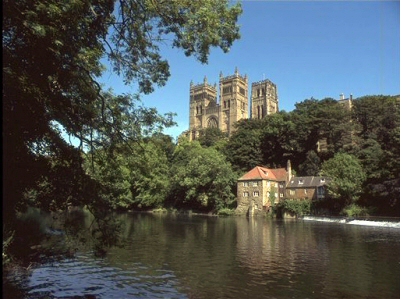 Durham Cathedral
was built in the late 11th and early 12th centuries to house the relics of St
Cuthbert (evangelizer of
Northumbria) and
the Venerable Bede. It attests to the importance of
the early Benedictine monastic community and is the largest and finest example
of Norman architecture in
England. The
innovative audacity of its vaulting foreshadowed Gothic architecture. Behind
the cathedral stands the castle, an ancient
Norman
fortress which was the residence of the prince-bishops of
Durham.
Durham Cathedral
was built in the late 11th and early 12th centuries to house the relics of St
Cuthbert (evangelizer of
Northumbria) and
the Venerable Bede. It attests to the importance of
the early Benedictine monastic community and is the largest and finest example
of Norman architecture in
England. The
innovative audacity of its vaulting foreshadowed Gothic architecture. Behind
the cathedral stands the castle, an ancient
Norman
fortress which was the residence of the prince-bishops of
Durham.
Hadrian's
Wall, England
(Inscribed: 1987)
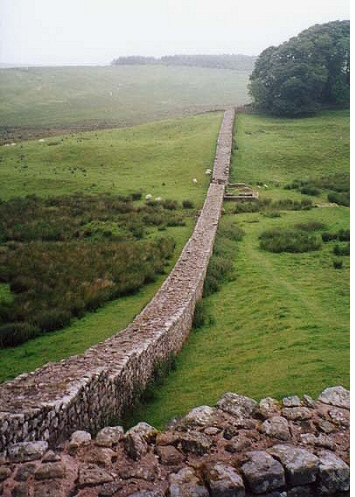 Built on the
orders of the Emperor Hadrian c. A.D. 122 at the northernmost limits of the
Roman
province of
Britannia, the
118-km-long wall is a striking example of the organization of a military zone.
It is a good illustration of the defensive techniques and geopolitical strategies
of ancient
Rome.
Built on the
orders of the Emperor Hadrian c. A.D. 122 at the northernmost limits of the
Roman
province of
Britannia, the
118-km-long wall is a striking example of the organization of a military zone.
It is a good illustration of the defensive techniques and geopolitical strategies
of ancient
Rome.
Ironbridge Gorge,
England (Inscribed:
1986)
 Ironbridge is known throughout the world as the
symbol of the Industrial Revolution. It contains all the elements of progress
that contributed to the rapid development of this industrial region in the 18th
century, from the mines themselves to the railway lines. Nearby, the blast
furnace of Coalbrookdale, built in 1708, is a
reminder of the discovery of coke. The bridge at Ironbridge,
the world's first bridge constructed of iron, had a considerable influence on
developments in the fields of technology and architecture.
Ironbridge is known throughout the world as the
symbol of the Industrial Revolution. It contains all the elements of progress
that contributed to the rapid development of this industrial region in the 18th
century, from the mines themselves to the railway lines. Nearby, the blast
furnace of Coalbrookdale, built in 1708, is a
reminder of the discovery of coke. The bridge at Ironbridge,
the world's first bridge constructed of iron, had a considerable influence on
developments in the fields of technology and architecture.
Maritime
Greenwich,
England
(Inscribed: 1997)
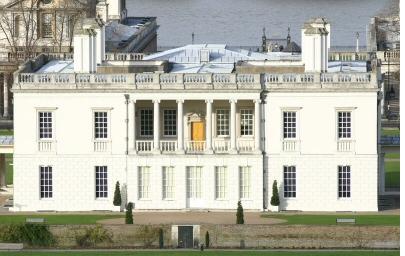 The ensemble of
buildings at
Greenwich, an
outlying district of London, and the park in which they
are set, symbolize English artistic and scientific endeavour in the 17th and
18th centuries. The Queen's House (by Inigo Jones
- on the picture)
was the first Palladian building in
England,
while the complex that was until recently the
Royal
Naval
College was
designed by Christopher Wren. The park, laid out on the basis of an original
design by André Le Nôtre, contains the Old Royal
Observatory, the work of Wren and the scientist Robert Hooke.
The ensemble of
buildings at
Greenwich, an
outlying district of London, and the park in which they
are set, symbolize English artistic and scientific endeavour in the 17th and
18th centuries. The Queen's House (by Inigo Jones
- on the picture)
was the first Palladian building in
England,
while the complex that was until recently the
Royal
Naval
College was
designed by Christopher Wren. The park, laid out on the basis of an original
design by André Le Nôtre, contains the Old Royal
Observatory, the work of Wren and the scientist Robert Hooke.
Royal
Botanic Gardens,
Kew,
England
(Inscribed: 2003)
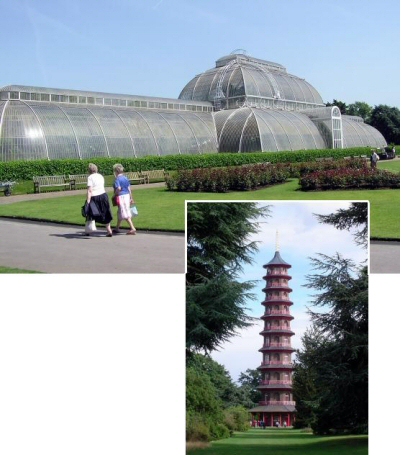 This historic
landscape garden features elements that illustrate significant periods of the art
of gardens from the eighteenth to the twentieth centuries. The gardens house
botanic collections (conserved plants, living plants and documents) that have
been considerably enriched through the centuries. Since their creation in 1759,
the gardens have made a significant and uninterrupted contribution to the study
of plant diversity and economic botany. Since the 18th century, the Botanic
Gardens of Kew have been closely associated with scientific and economic
exchanges established throughout the world in the field of botany, and this is
reflected in the richness of its collections. The landscape features and
architectural features of the gardens reflect considerable artistic influences
both with regard to the European continent and to more distant regions.
Kew
Gardens have
largely contributed to advances in many scientific disciplines, particularly
botany and ecology.
This historic
landscape garden features elements that illustrate significant periods of the art
of gardens from the eighteenth to the twentieth centuries. The gardens house
botanic collections (conserved plants, living plants and documents) that have
been considerably enriched through the centuries. Since their creation in 1759,
the gardens have made a significant and uninterrupted contribution to the study
of plant diversity and economic botany. Since the 18th century, the Botanic
Gardens of Kew have been closely associated with scientific and economic
exchanges established throughout the world in the field of botany, and this is
reflected in the richness of its collections. The landscape features and
architectural features of the gardens reflect considerable artistic influences
both with regard to the European continent and to more distant regions.
Kew
Gardens have
largely contributed to advances in many scientific disciplines, particularly
botany and ecology.
Saltaire, England
(Inscribed:
2001)
 Saltaire,
West Yorkshire, is a
complete and well-preserved industrial village of the second half of the 19th century.
Its textile mills, public buildings and workers' housing are built in a
harmonious style of high architectural standards and the urban plan survives
intact, giving a vivid impression of Victorian philanthropic paternalism. Saltaire is an outstanding and well preserved example of a
mid 19th-century industrial town, the layout of which was to exert a major
influence on the development of the "garden city" movement. The
layout and architecture of Saltaire admirably reflect
mid
19th-century philanthropic paternalism, as well as the important role
played by the textile industry in economic and social development.
Saltaire,
West Yorkshire, is a
complete and well-preserved industrial village of the second half of the 19th century.
Its textile mills, public buildings and workers' housing are built in a
harmonious style of high architectural standards and the urban plan survives
intact, giving a vivid impression of Victorian philanthropic paternalism. Saltaire is an outstanding and well preserved example of a
mid 19th-century industrial town, the layout of which was to exert a major
influence on the development of the "garden city" movement. The
layout and architecture of Saltaire admirably reflect
mid
19th-century philanthropic paternalism, as well as the important role
played by the textile industry in economic and social development.
Stonehenge, Avebury and
Associated Sites, England
(Inscribed:
1986)
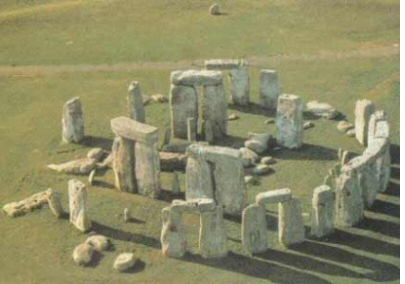 Stonehenge and Avebury, in Wiltshire, are among the most famous groups of
megaliths in the world. The two sanctuaries consist of circles of menhirs arranged in a pattern whose astronomical
significance is still being explored. These holy places and the nearby
Neolithic sites are an incomparable testimony to prehistoric times.
Stonehenge and Avebury, in Wiltshire, are among the most famous groups of
megaliths in the world. The two sanctuaries consist of circles of menhirs arranged in a pattern whose astronomical
significance is still being explored. These holy places and the nearby
Neolithic sites are an incomparable testimony to prehistoric times.
Studley Royal Park including the Ruins of
Fountains Abbey, England (Inscribed:
1986)
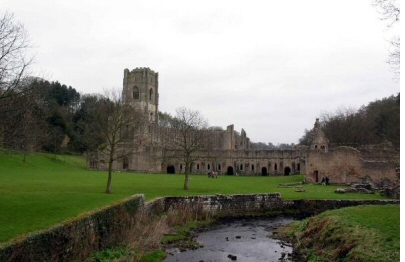 A striking
landscape was created around the ruins of the Cistercian Fountains Abbey and
Fountains
Hall
Castle, in
Yorkshire. The
18th-century landscaping, gardens and canal, the 19th-century plantations and
vistas, and the neo-Gothic
castle of
Studley Royal Park,
make this an outstanding site.
A striking
landscape was created around the ruins of the Cistercian Fountains Abbey and
Fountains
Hall
Castle, in
Yorkshire. The
18th-century landscaping, gardens and canal, the 19th-century plantations and
vistas, and the neo-Gothic
castle of
Studley Royal Park,
make this an outstanding site.
Tower of
London,
England
(Inscribed:
1988)
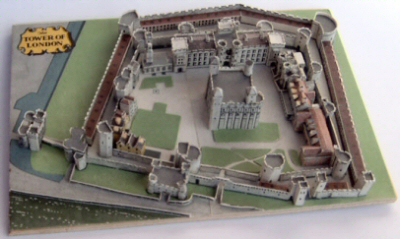 The massive
White
Tower (in
the middle) is a
typical example of Norman military architecture, whose influence was felt
throughout the kingdom. It was built on the
Thames by
William the Conqueror to protect
London and
assert his power. The
Tower of
London – an
imposing fortress with many layers of history, which has become one of the
symbols of royalty – was built around the
White
Tower.
The massive
White
Tower (in
the middle) is a
typical example of Norman military architecture, whose influence was felt
throughout the kingdom. It was built on the
Thames by
William the Conqueror to protect
London and
assert his power. The
Tower of
London – an
imposing fortress with many layers of history, which has become one of the
symbols of royalty – was built around the
White
Tower.
Westminster
Palace,
Westminster Abbey and Saint Margaret's Church,
England (Inscribed:
1987)
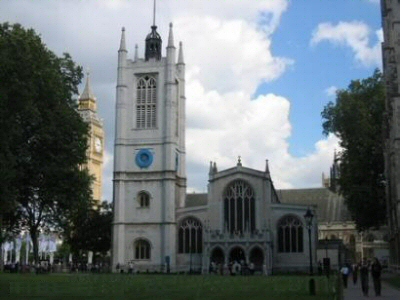 Westminster
Palace,
rebuilt from the year 1840 on the site of important medieval remains, is a fine
example of neo-Gothic architecture. The site – which also comprises the small
medieval
Church of
Saint
Margaret (on the picture), built in Perpendicular Gothic
style, and Westminster Abbey, where all the sovereigns since the 11th century
have been crowned – is of great historic and symbolic significance.
Westminster
Palace,
rebuilt from the year 1840 on the site of important medieval remains, is a fine
example of neo-Gothic architecture. The site – which also comprises the small
medieval
Church of
Saint
Margaret (on the picture), built in Perpendicular Gothic
style, and Westminster Abbey, where all the sovereigns since the 11th century
have been crowned – is of great historic and symbolic significance.
Northern
Ireland
Giant's Causeway, Northern Ireland (Inscribed: 1986)
 The
Giant's Causeway lies at the foot of the basalt cliffs along the sea coast on
the edge of the Antrim plateau in Northern Ireland. It is made up of some 40,000
massive black basalt columns sticking out of the sea. The dramatic sight has
inspired legends of giants striding over the sea to Scotland. Geological studies
of these formations over the last 300 years have greatly contributed to the
development of the earth sciences, and show that this striking landscape was
caused by volcanic activity.
The
Giant's Causeway lies at the foot of the basalt cliffs along the sea coast on
the edge of the Antrim plateau in Northern Ireland. It is made up of some 40,000
massive black basalt columns sticking out of the sea. The dramatic sight has
inspired legends of giants striding over the sea to Scotland. Geological studies
of these formations over the last 300 years have greatly contributed to the
development of the earth sciences, and show that this striking landscape was
caused by volcanic activity.
Scotland
Old and New Towns of
Edinburgh,
Scotland (Inscribed: 1995)
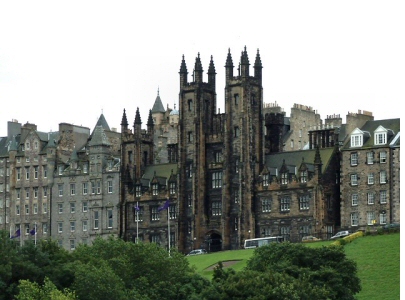 Edinburgh has been
the Scottish capital since the 15th century. It has two distinct areas: the
Old
Town,
dominated by a medieval fortress; and the neoclassical New Town, whose
development from the 18th century onwards had a far-reaching influence on
European urban planning. The harmonious juxtaposition of these two contrasting
historic areas, each with many important buildings, is what gives the city its
unique character.
Edinburgh has been
the Scottish capital since the 15th century. It has two distinct areas: the
Old
Town,
dominated by a medieval fortress; and the neoclassical New Town, whose
development from the 18th century onwards had a far-reaching influence on
European urban planning. The harmonious juxtaposition of these two contrasting
historic areas, each with many important buildings, is what gives the city its
unique character.
New Lanark,
South
Lanarkshire, Scotland (Inscribed: 2001)
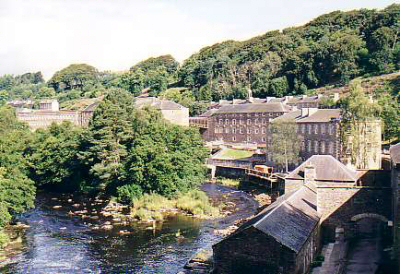 New Lanark is a small 18th century
village set in a sublime Scottish landscape where the philanthropist and
Utopian idealist Robert Owen moulded a model industrial community in the early
19th century. The imposing cotton mill buildings, the spacious and
well-designed workers' housing, and the dignified educational institute and
school still testify to Owen's humanism. When Richard
Arkwright's new factory system for textile production
was brought to New Lanark the need to provide housing and other facilities to
the workers and managers was recognized. It was then that Robert Owen created
a model for industrial communities that was to spread
across the world in the 19th and 20th centuries. New Lanark saw the
construction not only of well designed and equipped workers' housing but also public
buildings designed to improve their spiritual as well as their physical needs.
The name of New Lanark is synonymous with that of Robert Owen and his social
philosophy in matters such as progressive education, factory reform, humane
working practices, international cooperation, and garden cities, which was to
have a profound influence on social developments throughout the 19th century
and beyond.
New Lanark is a small 18th century
village set in a sublime Scottish landscape where the philanthropist and
Utopian idealist Robert Owen moulded a model industrial community in the early
19th century. The imposing cotton mill buildings, the spacious and
well-designed workers' housing, and the dignified educational institute and
school still testify to Owen's humanism. When Richard
Arkwright's new factory system for textile production
was brought to New Lanark the need to provide housing and other facilities to
the workers and managers was recognized. It was then that Robert Owen created
a model for industrial communities that was to spread
across the world in the 19th and 20th centuries. New Lanark saw the
construction not only of well designed and equipped workers' housing but also public
buildings designed to improve their spiritual as well as their physical needs.
The name of New Lanark is synonymous with that of Robert Owen and his social
philosophy in matters such as progressive education, factory reform, humane
working practices, international cooperation, and garden cities, which was to
have a profound influence on social developments throughout the 19th century
and beyond.
The Heart of Neolithic Orkney,
Scotland (Inscribed:1999)
 The group of Neolithic
monuments on Orkney consists of a large chambered tomb (Maes
Howe), two ceremonial stone circles (the Stones of Stenness
and the Ring of Brodgar) and a settlement (Skara Brae), together with a number of unexcavated burial,
ceremonial and settlement sites. The group constitutes a major prehistoric
cultural landscape which gives a graphic depiction of life in this remote
archipelago in the far north of
Scotland some 5,000 years
ago. The monuments of Orkney, dating back to 3000-2000 BC, are outstanding
testimony to the cultural achievements of the Neolithic peoples of northern
Europe.
The group of Neolithic
monuments on Orkney consists of a large chambered tomb (Maes
Howe), two ceremonial stone circles (the Stones of Stenness
and the Ring of Brodgar) and a settlement (Skara Brae), together with a number of unexcavated burial,
ceremonial and settlement sites. The group constitutes a major prehistoric
cultural landscape which gives a graphic depiction of life in this remote
archipelago in the far north of
Scotland some 5,000 years
ago. The monuments of Orkney, dating back to 3000-2000 BC, are outstanding
testimony to the cultural achievements of the Neolithic peoples of northern
Europe.
St. Kilda,
Outer
Hebrides, Scotland (Inscribed:1986)
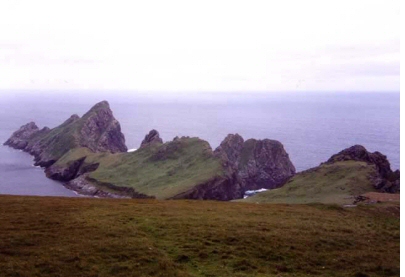 This volcanic archipelago, with its
spectacular landscapes, is situated off the coast of the
Hebrides and
comprises the islands of Hirta, Dun, Soay and Boreray. It has some of
the highest cliffs in
Europe,
which have large colonies of rare and endangered species of birds, especially
puffins and gannets.
This volcanic archipelago, with its
spectacular landscapes, is situated off the coast of the
Hebrides and
comprises the islands of Hirta, Dun, Soay and Boreray. It has some of
the highest cliffs in
Europe,
which have large colonies of rare and endangered species of birds, especially
puffins and gannets.
Wales
Blaenavon Industrial Landscape,
40 km NE of
Cardiff, Wales (Inscribed: 2000)
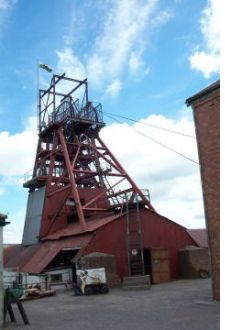 The Blaenavon landscape constitutes an exceptional illustration
in material form of the social and economic structure of 19th century industry.
The components of the Blaenavon industrial landscape
together make up an outstanding and remarkably complete example of a 19th
century industrial landscape. The area around Blaenavon
is evidence of the pre-eminence of
South Wales as
the world's major producer of iron and coal in the 19th century. All the
necessary elements can still be seen - coal and ore mines, quarries, a
primitive railway system, furnaces, workers' homes, and the social
infrastructure of their community.
The Blaenavon landscape constitutes an exceptional illustration
in material form of the social and economic structure of 19th century industry.
The components of the Blaenavon industrial landscape
together make up an outstanding and remarkably complete example of a 19th
century industrial landscape. The area around Blaenavon
is evidence of the pre-eminence of
South Wales as
the world's major producer of iron and coal in the 19th century. All the
necessary elements can still be seen - coal and ore mines, quarries, a
primitive railway system, furnaces, workers' homes, and the social
infrastructure of their community.
Castles and Town Walls of King Edward in
Gwynedd,
North
Wales (Inscribed: 1986)
 The castles of Beaumaris
and Harlech (largely the work of the greatest
military engineer of the time, James of St George) and the fortified complexes
of Caernarfon and Conwy (left) are located in the former principality
of Gwynedd, in north
Wales.
These extremely well-preserved monuments are examples of the colonization and
defence works carried out throughout the reign of Edward I (1272–1307) and the
military architecture of the time.
The castles of Beaumaris
and Harlech (largely the work of the greatest
military engineer of the time, James of St George) and the fortified complexes
of Caernarfon and Conwy (left) are located in the former principality
of Gwynedd, in north
Wales.
These extremely well-preserved monuments are examples of the colonization and
defence works carried out throughout the reign of Edward I (1272–1307) and the
military architecture of the time.
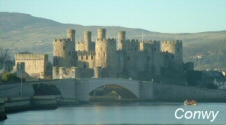
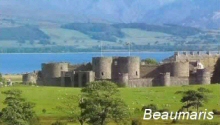
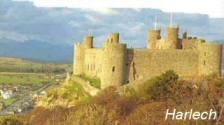
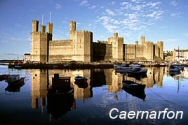
Outside the
British
Isles
Gough
Island Wildlife Reserve (Inscribed: 1995)
Gough
Island, in
the
South Atlantic, is
one of the least-disrupted island and marine ecosystems in the cool temperate
zone. The spectacular cliffs, towering above the ocean, are home to one of the
world's largest colonies of sea birds. The island is also home to two endemic
species of land birds, the gallinule and the Gough rowettie,
as well as to 12 endemic species of plants.
Henderson
Island
(Inscribed: 1988)
Henderson
Island,
which lies in the eastern South Pacific,
is one of the few atolls in the world whose ecology has been practically
untouched by a human presence. Its isolated location provides the ideal context
for studying the dynamics of insular evolution and natural selection. It is
particularly notable for the 10 plants and four land birds that are endemic to
the island.
The Historic Town of
St George and Related Fortifications,
Bermuda (Inscribed:
2000)
The Town of
St
George, founded in 1612, is an outstanding
example of the earliest English urban settlement in the
New
World. Its associated fortifications graphically illustrate
the development of English military engineering from the 17th to the 20th
century, being adapted to take account of the development of artillery over
this period.
source &
credits:
Short descriptions:
World Heritage Sites
© UNESCO World Heritage 2006
 Founded by the Romans as a thermal
spa,
Founded by the Romans as a thermal
spa,  Blenheim
Blenheim Canterbury
Canterbury The
The  The cliff
exposures along the
The cliff
exposures along the  Durham Cathedral
was built in the late 11th and early 12th centuries to house the relics of St
Cuthbert (evangelizer of
Durham Cathedral
was built in the late 11th and early 12th centuries to house the relics of St
Cuthbert (evangelizer of  Built on the
orders of the Emperor Hadrian c. A.D. 122 at the northernmost limits of the
Roman
Built on the
orders of the Emperor Hadrian c. A.D. 122 at the northernmost limits of the
Roman  Ironbridge is known throughout the world as the
symbol of the Industrial Revolution. It contains all the elements of progress
that contributed to the rapid development of this industrial region in the 18th
century, from the mines themselves to the railway lines. Nearby, the blast
furnace of Coalbrookdale, built in 1708, is a
reminder of the discovery of coke. The bridge at Ironbridge,
the world's first bridge constructed of iron, had a considerable influence on
developments in the fields of technology and architecture.
Ironbridge is known throughout the world as the
symbol of the Industrial Revolution. It contains all the elements of progress
that contributed to the rapid development of this industrial region in the 18th
century, from the mines themselves to the railway lines. Nearby, the blast
furnace of Coalbrookdale, built in 1708, is a
reminder of the discovery of coke. The bridge at Ironbridge,
the world's first bridge constructed of iron, had a considerable influence on
developments in the fields of technology and architecture. The ensemble of
buildings at
The ensemble of
buildings at This historic
landscape garden features elements that illustrate significant periods of the art
of gardens from the eighteenth to the twentieth centuries. The gardens house
botanic collections (conserved plants, living plants and documents) that have
been considerably enriched through the centuries. Since their creation in 1759,
the gardens have made a significant and uninterrupted contribution to the study
of plant diversity and economic botany. Since the 18th century, the Botanic
Gardens of Kew have been closely associated with scientific and economic
exchanges established throughout the world in the field of botany, and this is
reflected in the richness of its collections. The landscape features and
architectural features of the gardens reflect considerable artistic influences
both with regard to the European continent and to more distant regions.
 Saltaire,
Saltaire,  Stonehenge
Stonehenge A striking
landscape was created around the ruins of the Cistercian Fountains Abbey and
A striking
landscape was created around the ruins of the Cistercian Fountains Abbey and  The massive
The massive  Westminster
Westminster The
Giant's Causeway lies at the foot of the basalt cliffs along the sea coast on
the edge of the Antrim plateau in Northern Ireland. It is made up of some 40,000
massive black basalt columns sticking out of the sea. The dramatic sight has
inspired legends of giants striding over the sea to Scotland. Geological studies
of these formations over the last 300 years have greatly contributed to the
development of the earth sciences, and show that this striking landscape was
caused by volcanic activity.
The
Giant's Causeway lies at the foot of the basalt cliffs along the sea coast on
the edge of the Antrim plateau in Northern Ireland. It is made up of some 40,000
massive black basalt columns sticking out of the sea. The dramatic sight has
inspired legends of giants striding over the sea to Scotland. Geological studies
of these formations over the last 300 years have greatly contributed to the
development of the earth sciences, and show that this striking landscape was
caused by volcanic activity. Edinburgh
Edinburgh New Lanark is a small 18th century
village set in a sublime Scottish landscape where the philanthropist and
Utopian idealist Robert Owen moulded a model industrial community in the early
19th century. The imposing cotton mill buildings, the spacious and
well-designed workers' housing, and the dignified educational institute and
school still testify to Owen's humanism. When Richard
Arkwright's new factory system for textile production
was brought to New Lanark the need to provide housing and other facilities to
the workers and managers was recognized. It was then that Robert Owen created
a model for industrial communities that was to spread
across the world in the 19th and 20th centuries. New Lanark saw the
construction not only of well designed and equipped workers' housing but also public
buildings designed to improve their spiritual as well as their physical needs.
The name of New Lanark is synonymous with that of Robert Owen and his social
philosophy in matters such as progressive education, factory reform, humane
working practices, international cooperation, and garden cities, which was to
have a profound influence on social developments throughout the 19th century
and beyond.
New Lanark is a small 18th century
village set in a sublime Scottish landscape where the philanthropist and
Utopian idealist Robert Owen moulded a model industrial community in the early
19th century. The imposing cotton mill buildings, the spacious and
well-designed workers' housing, and the dignified educational institute and
school still testify to Owen's humanism. When Richard
Arkwright's new factory system for textile production
was brought to New Lanark the need to provide housing and other facilities to
the workers and managers was recognized. It was then that Robert Owen created
a model for industrial communities that was to spread
across the world in the 19th and 20th centuries. New Lanark saw the
construction not only of well designed and equipped workers' housing but also public
buildings designed to improve their spiritual as well as their physical needs.
The name of New Lanark is synonymous with that of Robert Owen and his social
philosophy in matters such as progressive education, factory reform, humane
working practices, international cooperation, and garden cities, which was to
have a profound influence on social developments throughout the 19th century
and beyond. The group of Neolithic
monuments on Orkney consists of a large chambered tomb (Maes
Howe), two ceremonial stone circles (the Stones of Stenness
and the Ring of Brodgar) and a settlement (Skara Brae), together with a number of unexcavated burial,
ceremonial and settlement sites. The group constitutes a major prehistoric
cultural landscape which gives a graphic depiction of life in this remote
archipelago in the far north of
The group of Neolithic
monuments on Orkney consists of a large chambered tomb (Maes
Howe), two ceremonial stone circles (the Stones of Stenness
and the Ring of Brodgar) and a settlement (Skara Brae), together with a number of unexcavated burial,
ceremonial and settlement sites. The group constitutes a major prehistoric
cultural landscape which gives a graphic depiction of life in this remote
archipelago in the far north of  This volcanic archipelago, with its
spectacular landscapes, is situated off the coast of the
This volcanic archipelago, with its
spectacular landscapes, is situated off the coast of the  The Blaenavon landscape constitutes an exceptional illustration
in material form of the social and economic structure of 19th century industry.
The components of the Blaenavon industrial landscape
together make up an outstanding and remarkably complete example of a 19th
century industrial landscape. The area around Blaenavon
is evidence of the pre-eminence of
The Blaenavon landscape constitutes an exceptional illustration
in material form of the social and economic structure of 19th century industry.
The components of the Blaenavon industrial landscape
together make up an outstanding and remarkably complete example of a 19th
century industrial landscape. The area around Blaenavon
is evidence of the pre-eminence of  The castles of Beaumaris
and Harlech (largely the work of the greatest
military engineer of the time, James of St George) and the fortified complexes
of Caernarfon and Conwy (left) are located in the former principality
of Gwynedd, in north
The castles of Beaumaris
and Harlech (largely the work of the greatest
military engineer of the time, James of St George) and the fortified complexes
of Caernarfon and Conwy (left) are located in the former principality
of Gwynedd, in north 


